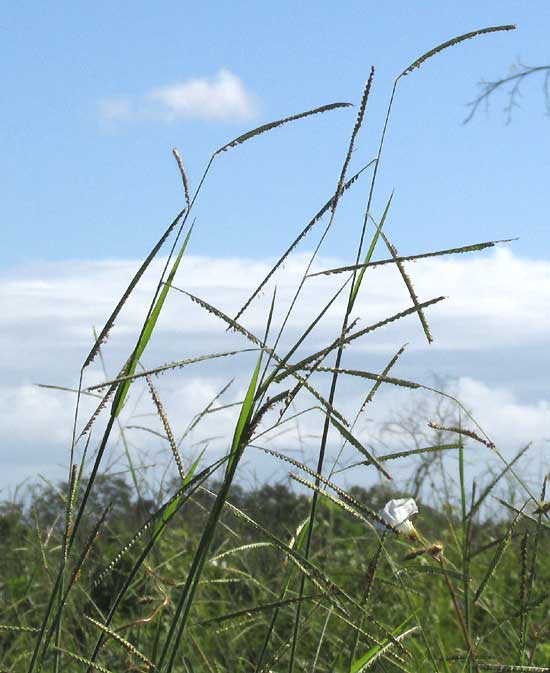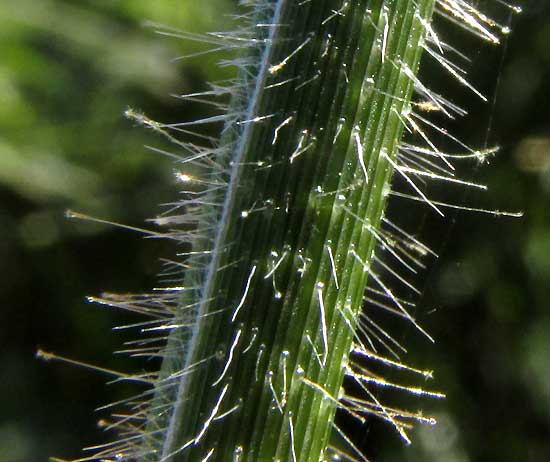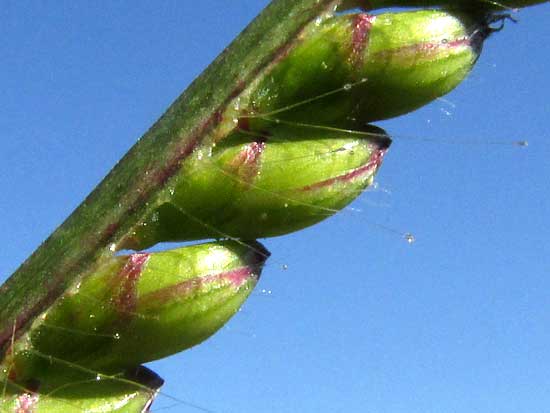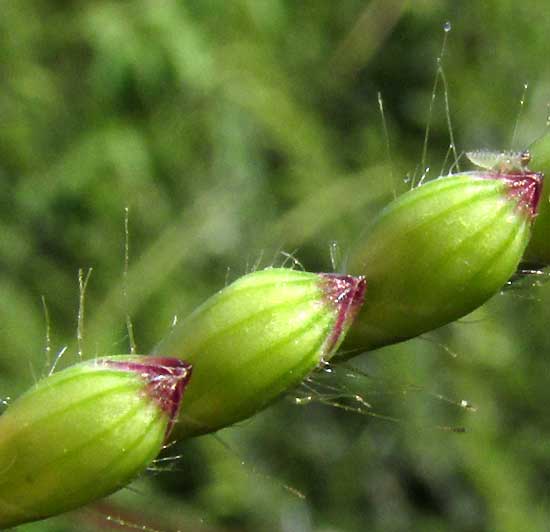Excerpts from Jim Conrad's
Naturalist Newsletter
from the October 30, 2016 Newsletter issued from Rancho Regenesis in the woods ±4kms west of Ek Balam Ruins; elevation ~40m (~130 ft), N20.876°, W88.170°; north-central Yucatán, MÉXICO
INSURGENTE GRASS
Around the rancho there's a seven-ft-tall grass species I've been wondering about. The grass's general appearance is just like that of the abundant African Guinea-Grass that normally dominates roadsides and weedy fields in this area, and it grows in the same habitats as Guinea-Grass. However, its diffuse flowering heads are very different. For comparison, first you can see Guinea-Grass's flowering heads at ../yucatan/guinea-g
The very different flowering heads of this other seven-ft-tall I'm talking about are shown

This big grass is hairy. Below, on its stem, you can see its stiff hairs often tipped with glands and arising from swollen bases:

The flowering heads consist of spike-like divisions on which the individual spikelets, each containing a single floret, array themselves along just one side of the stem-like rachilla, as shown

Looking at the rachilla from below, you can see that the spikelets are aligned one above the other, and that they bear sparse but long, often gland-tipped hairs, shown below:

The big, hairy grass has ligules consisting of a fringe of fine, short hairs forming a kind of collar where the blades make contact with the stem, as shown

During my surprise afternoon with Internet access I needed four solid hours to figure out this grass's identity, and it sure was fun. At first I was almost certain that our grass was a member of the genus Paspalum, like the Paspalum langei we profiled at Chichén Itzá this August. You can review how similar that species was compared to our present one at www.backyardnature.net/mexnat/paspalum.htm
Several Paspalum species are listed for the Yucatan, but our unknown grass wasn't any of them. In fact, it turned out that our mystery grass is not listed at all by CICY, Yucatan's Center of Scientific Investigation, as existing in the Yucatan.
Our mystery plant is BRACHIARIA BRIZANTHA, in English variously known as Beard Grass, Palisade Grass, Palisade Signal Grass, and -- what seems most appropriate to me -- Insurgente Grass. Appropriate, because from what I can see this robust species from Africa is rapidly pushing aside our native Guinea-Grass, which itself is known as extremely vigorous and aggressive.
Genetically, Insurgente Grass is described as predominantly polyploid and apomictic. Polyploid species may arise abruptly when during meiosis chromosomes in a parent species don't separate as they were supposed to, resulting in a new species with twice, thrice, or some other multiple of the parents' chromosome number. Polyploids can't cross with their parents or other species with different chromosome number, may look quite different from them, thus constitute a spontaneously appearing, new species.
Apomictic species are those who produce normal looking seeds, but the seeds don't result from normal sexual fertilization; rather, genetically, they're clones of their mother plant.
How did this kinky African Insurgente Grass get to the Yucatan? It was intentionally introduced into the northern Yucatan on the grounds that it makes a superior forage plant for livestock, and is able to thrive on thin soils developed atop limestone in a tropical environment -- exactly like we have in the Yucatan.
In the immediate area around the rancho, Insurgente Grass is fairly common, appearing as small islands of plants within an ocean of Guinea-Grass. However, this week I got to travel the 80kms or so between here and Río Lagartos directly north of us and over the entire distance I saw abundant Guinea-Grass along the road and in pastures, but only four or five small populations of Insurgente Grass, mostly in the cattle-producing region just north of Tizimín. However, those small populations of Insurgente Grass were nearly purely Insurgente Grass, with little to no Guinea-Grass mingling with it.
When I see how aggressively Insurgente Grass is taking the place of Guinea-Grass, and noticing that Insurgente Grass produces much fewer wildlife-nurturing grains than our native Guinea-Grass, I wonder if introducing it here was a good idea.